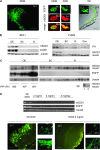Unexpected expression pattern of tetracycline-regulated transgenes in mice
- PMID: 19204377
- PMCID: PMC2666531
- DOI: 10.1534/genetics.108.097600
Unexpected expression pattern of tetracycline-regulated transgenes in mice
Abstract
In generating a conditional transgenic murine model based on a tetracycline-regulated system, we obtained unexpected patterns of expression due to the transcriptional inactivity of the tet-responder promoter. Here we show strong cell-type-restricted expression that was variegated to an extent determined by the number of responder transgene copies integrated into the host genome.
Figures



Similar articles
-
Tetracycline-regulated gene expression in the NSC-34-tTA cell line for investigation of motor neuron diseases.Brain Res Mol Brain Res. 2005 Oct 31;140(1-2):63-72. doi: 10.1016/j.molbrainres.2005.07.010. Epub 2005 Aug 24. Brain Res Mol Brain Res. 2005. PMID: 16125275
-
Comparison of Tetracycline-regulated Promoters in Lentiviral-based Vectors in Murine Transplantation Studies.Curr Gene Ther. 2016;16(4):242-248. doi: 10.2174/1566523216666161013125215. Curr Gene Ther. 2016. PMID: 27739375
-
Decreased alloreactivity using donor cells from mice expressing a CD200 transgene under control of a tetracycline-inducible promoter.Transplantation. 2005 Aug 15;80(3):394-401. doi: 10.1097/01.tp.0000168152.72560.82. Transplantation. 2005. PMID: 16082336
-
Principles for the use of in vivo transgene techniques: overview and an introductory practical guide for the selection of tetracycline-controlled transgenic mice.Methods Mol Biol. 2014;1142:33-40. doi: 10.1007/978-1-4939-0404-4_4. Methods Mol Biol. 2014. PMID: 24706272 Review.
-
Transposon-mediated stable integration and tetracycline-inducible expression of electroporated transgenes in chicken embryos.Methods Cell Biol. 2008;87:271-80. doi: 10.1016/S0091-679X(08)00214-8. Methods Cell Biol. 2008. PMID: 18485302 Review. No abstract available.
Cited by
-
A previously functional tetracycline-regulated transactivator fails to target gene expression to the bone.BMC Res Notes. 2011 Aug 11;4:282. doi: 10.1186/1756-0500-4-282. BMC Res Notes. 2011. PMID: 21835026 Free PMC article.
-
Acute intermittent hypoxia induced phrenic long-term facilitation despite increased SOD1 expression in a rat model of ALS.Exp Neurol. 2015 Nov;273:138-50. doi: 10.1016/j.expneurol.2015.08.011. Epub 2015 Aug 16. Exp Neurol. 2015. PMID: 26287750 Free PMC article.
-
Anatomically defined neuron-based rescue of neurodegenerative Niemann-Pick type C disorder.J Neurosci. 2011 Mar 23;31(12):4367-78. doi: 10.1523/JNEUROSCI.5981-10.2011. J Neurosci. 2011. PMID: 21430138 Free PMC article.
-
Low levels of the reverse transactivator fail to induce target transgene expression in vascular smooth muscle cells.PLoS One. 2014 Aug 4;9(8):e104098. doi: 10.1371/journal.pone.0104098. eCollection 2014. PLoS One. 2014. PMID: 25090270 Free PMC article.
-
Reporter mice express green fluorescent protein at initiation of meiosis in spermatocytes.Genesis. 2014 Dec;52(12):976-84. doi: 10.1002/dvg.22830. Epub 2014 Nov 14. Genesis. 2014. PMID: 25293348 Free PMC article.
References
-
- Babetto, E., A. Mangolini, M. Rizzardini, M. Lupi, L. Conforti et al., 2005. Tetracycline-regulated gene expression in the NSC-34-tTA cell line for investigation of motor neuron diseases. Brain Res. Mol. Brain Res. 140 63–72. - PubMed
-
- Bockamp, E., M. Maringer, C. Spangenberg, S. Fees, S. Fraser et al., 2002. Of mice and models: improved animal models for biomedical research. Physiol. Genomics 11 115–132. - PubMed
-
- Böger, H., and P. Gruss, 1999. Functional determinants for the tetracycline-dependent transactivator tTA in transgenic mouse embryos. Mech. Dev. 83 141–153. - PubMed
-
- Boy, J., T. V. Leergaard, T. Schmidt, F. Odeh, U. Bichelmeier et al., 2006. Expression mapping of tetracycline-responsive prion protein promoter: digital atlasing for generating cell-specific disease models. Neuroimage 33 449–462. - PubMed
-
- Fedorov, L. M., O. Y. Tyrsin, O. Sakk, A. Ganscher and U. R. Rapp, 2001. Generation dependent reduction of tTA expression in double transgenic NZL-2/tTACMV mice. Genesis 31 78–84. - PubMed
Publication types
MeSH terms
Substances
LinkOut - more resources
Full Text Sources
Other Literature Sources
Molecular Biology Databases

